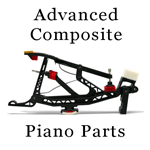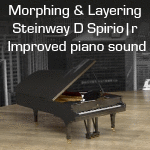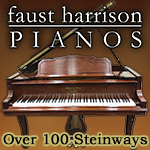 |
Welcome to the Piano World Piano Forums
Over 3 million posts about pianos, digital pianos, and all types of keyboard instruments.
Over 100,000 members from around the world.
Join the World's Largest Community of Piano Lovers
(it's free)
It's Fun to Play the Piano ... Please Pass It On!
|
|
|
|
84 members (Alex C, BlakeOR, Beowulf, Abdol, Boboulus, brdwyguy, 8ude, Animisha, 16 invisible),
710
guests, and
558
robots. |
|
Key:
Admin,
Global Mod,
Mod
|
|
 The tuning pin twist?
|
Joined: Oct 2020
Posts: 706
500 Post Club Member
|
OP

500 Post Club Member
Joined: Oct 2020
Posts: 706 |
How much twist would a tuning pin twist, if a tuning pin really could twist?
The field of solid mechanics have torsion in round shafts all worked out. Using a simple formula, anyone can calculate the degree of twist of an object due to an applied toque. There are free online calculators that make this process even easier. But first, we have to gather some information.
I needed to increase the torque readings for a tung pin by installing a longer pin, so I took note of the characteristics of that situation so we have a real-life example to reference. The pin was a 3/0 pin with a diameter of .286” (7.26mm) that was 2 3/8” (60.3mm) long. With the pin at 24.38mm above the plate, the torque reading was 77in/lbs.
For a 60.3mm tuning pin, 8mm of the foot of the pin doesn’t make contact with the pinblock [that part of the tuning pin is tapered], 19.12mm is in contact with the pinblock, 33.18mm is above the pinblock, the head of the tuning pin [the middle of the eye to the top of the head] is 16mm, and the top of the pinblock to the middle of the eye is 17.18mm.
So, how much does this pin twist?
Well, first, we have to acknowledge that the non-touching foot (8mm) and the head of the tuning pin (16mm) is not part of the equation. The lengths that matter are the following:
Contact with the block = 19.12mm
Top of pinblock to the eye = 17.18mm
If we were to combine these two lengths of the tuning pin we would get 36.30mm. We could plug that information into the formula, and if we did, we would get an angular deflection of 0.8595 degrees. So, is that it? Does the pin twist 0.8595 degrees before it moves? No. It is much less than that—in order to figure that out you have to figure out how each segment of the pin moves. The part of the pin that is above the pinblock [to the eye] moves 0.4068 degrees with 77in/lbs of torque applied. But, don’t forget, once the force is removed, that 0.4068 degrees goes back to zero. Unless we want to factor in the interaction with the coil, but I will leave that to the side for now.
To figure out how the pin functions in the pinblock, we need to get measurements (torque readings and lengths). When extracting the pin. I took torque readings every half turn.
(Contact with pinblock in mm = in/lbs of torque)
19.12 = 77
18.17 = 70
17.18 = 62
16.33 = 58
15.46 = 50
14.66 = 47
13.65 = 42
12.97 = 40
12.15 = 38
11.62 = 35
10.94 = 27
10.23 = 25
9.5 = 22
8.85 = 17
8.14 = 15
7.69 = 11
7.03 = 10
6.4 = 8
5.69 = 5
For each of those measurements, we have to calculate how much twist is happen in each segment of the pin, based on the torque measured. For a little more than the first half of the tuning pin, or 10.23mm of contact with the pinblock, there is 0.2119 degrees of twist. For the next quarter of the pin, there is 0.052 degrees, and for the last quarter of the pin in the pinblock there is 0.0177 degrees of twist.
CONCLUSIONS
The tuning pin above the pinblock to the eye twists the most with a deflection of 0.4068 degrees. As soon as the force of the tuning hammer is released, or the entire tuning pin starts moving, that part of the twist goes away. There is nothing that a tuner would need to do to compensate for this twist in the pin. The first half of the pin in the block represents 0.2119 degrees with a maximum torque 25in/lbs (the first 1/4 of that has only 5in/lbs of torque). These torque reading are so minimal that the chances of the pinblock holding onto any of this twist is equally as slim.
For argument sake, perhaps the last quarter of the tuning pin gets stuck in a twist and held there by the pinblock. This hasn’t been proven, but let’s just say that MIGHT be possible. How much twist are we talking about? It is a measly 0.0177 degree deflection. This amount of pin twist does not account for what tuners refer to as “setting the pin.” Even if we assume that half of the pin in the pinblock stores a twist in the block, we are still only talking about 0.0697 degrees. If half of the tuning pin in the pinblock cannot account for even 1/10 of a degree of deflection, then talking about tuning pin twist in tuning technique is simply barking up the wrong tree.
Pin flexing and shifting positions in the hole, however, is a real thing, and something that needs to be compensated for. Yes, “setting the pin” is a real thing, but it is not due to twist, it is due to flex. That matters to tuning technique as a twist would be primarily at the bottom, whereas flex would happen primarily at the top. And, as I have previously noted, setting the pin doesn’t happen the same way when raising the pitch with the left hand vs. the right hand.
A flexing pin, that shift around in the hole, and a twisting pin is different.
|
|
|
 Re: The tuning pin twist?
|
Joined: Jan 2014
Posts: 279
Full Member
|

Full Member
Joined: Jan 2014
Posts: 279 |
How many degrees do you have to turn a tuning pin to raise the pitch by 50 cents?
|
|
|
 Re: The tuning pin twist?
|
Joined: Apr 2015
Posts: 229
Full Member
|

Full Member
Joined: Apr 2015
Posts: 229 |
For middle C assuming tuning length of 750mm to raise pitch by 50 cents it needs to stretch 0.2mm, which is 2.86 degrees for 7mm tuning pin and 1mm wire.
For change of 1 cent it stretches 0.0037mm and this equals 0.053 degrees of rotation.
If i made a mistake in calculations please feel free to correct it
|
|
|
 Re: The tuning pin twist?
|
Joined: Oct 2020
Posts: 706
500 Post Club Member
|
OP

500 Post Club Member
Joined: Oct 2020
Posts: 706 |
Getting to a similar number in a completely different way, it takes me an estimated 40-55 degrees of pin movement to bring a string into pitch (around C6), which is around 700 cents. So, I get an estimated 0.057 - 0.079 degrees of rotation for a 1 cent move.
So, for the bottom quarter of the pin, if the twist would stick then later release, we are talking about 0.2 -0.3 cent move lower in tension.
For the non-practicing technicians among us, I would estimate that "setting the pin" technique happens in the 5-15 cent range.
|
|
|
 Re: The tuning pin twist?
|
Joined: Feb 2017
Posts: 3,808
3000 Post Club Member
|

3000 Post Club Member
Joined: Feb 2017
Posts: 3,808 |
Takes me just the right amount to get it there. 😁
Peter Grey Piano Doctor
|
|
|
 Re: The tuning pin twist?
|
Joined: Jan 2014
Posts: 279
Full Member
|

Full Member
Joined: Jan 2014
Posts: 279 |
For middle C assuming tuning length of 750mm to raise pitch by 50 cents it needs to stretch 0.2mm, which is 2.86 degrees for 7mm tuning pin and 1mm wire.
For change of 1 cent it stretches 0.0037mm and this equals 0.053 degrees of rotation.
If i made a mistake in calculations please feel free to correct it Ok, your math looks fine getting from the length of string to degrees rotation. I don't know how you got from cents to stretch, but assuming you're correct, and that piano411 is correct in his/her calculations above, then 1 cent from 0.053 degrees of rotation is smaller than the .0697 degrees of twist in the assumption that half the pin remains twisted in the pin block. If it's enough to throw out a unison I wouldn't write it off as insignificant.
|
|
|
 Re: The tuning pin twist?
|
Joined: Dec 2012
Posts: 5,760
5000 Post Club Member
|

5000 Post Club Member
Joined: Dec 2012
Posts: 5,760 |
Very interesting, Thank you 411, Anthony, and Ambozy.
One more thing to consider though is the elastic deformation of the block. When flexing a tuning pin you will cause some crushing of the wood that will creep back to some degree over a couple of hours to days. This will change the forces on the pin and I suspect is responsible for short term tuning instability. Whereas torsional deformation of the tuning pin can be made permanent by repeated nudges in the desired direction.
Very loose pins won't allow any torsional deformation of the pin, and this is why pianos with pins tight enough to hold pitch are still too loose to fine tune stably. Especially if the string friction is high.
In a seemingly infinite universe-infinite human creativity is-seemingly possible.
According to NASA, 93% of the earth like planets possible in the known universe have yet to be formed.
Contact: toneman1@me.com
|
|
|
 Re: The tuning pin twist?
|
Joined: Nov 2008
Posts: 6,339
6000 Post Club Member
|

6000 Post Club Member
Joined: Nov 2008
Posts: 6,339 |
For middle C assuming tuning length of 750mm to raise pitch by 50 cents it needs to stretch 0.2mm, which is 2.86 degrees for 7mm tuning pin and 1mm wire.
For change of 1 cent it stretches 0.0037mm and this equals 0.053 degrees of rotation.
If i made a mistake in calculations please feel free to correct it Ok, your math looks fine getting from the length of string to degrees rotation. I don't know how you got from cents to stretch, but assuming you're correct, and that piano411 is correct in his/her calculations above, then 1 cent from 0.053 degrees of rotation is smaller than the .0697 degrees of twist in the assumption that half the pin remains twisted in the pin block. If it's enough to throw out a unison I wouldn't write it off as insignificant. I agree, can't write it off as insignificant, especially when these numbers are based on only 75 in lb of torque. The higher the torque, the more significant. A rough estimate from my actual readings is that the residual twist (that left in the pinblock) is about 1/6th of the maximum twist - when a slow pull results in the foot moving. This seems to agree with 411's calculations. I think what makes it significant or not is the rendering friction. With a low torque pin and high rendering friction, the residual twist may mean little. But with a high torque pin and low rendering friction it is very significant! Also, for me, "setting the pin" includes rendering the string. The whole shebang needs to be balanced to result in a stable tuning.
Jeff Deutschle
Part-Time Tuner
Who taught the first chicken how to peck?
|
|
|
 Re: The tuning pin twist?
|
Joined: Feb 2017
Posts: 3,808
3000 Post Club Member
|

3000 Post Club Member
Joined: Feb 2017
Posts: 3,808 |
Balance is the key.
Peter Grey Piano Doctor
|
|
|
 Re: The tuning pin twist?
|
Joined: May 2013
Posts: 2,835
2000 Post Club Member
|

2000 Post Club Member
Joined: May 2013
Posts: 2,835 |
but in-balance is not meaning equal NSL and SL tensions.
Ian
I'm all keyed up
2016 Blüthner Model A
|
|
|
 Re: The tuning pin twist?
|
Joined: Nov 2008
Posts: 6,339
6000 Post Club Member
|

6000 Post Club Member
Joined: Nov 2008
Posts: 6,339 |
but in-balance is not meaning equal NSL and SL tensions.
Ian I'd say somewhat equal NSL and SL tensions is only part of being in-balance. The more rendering friction, the less critical the tension differences are. Being in-balance includes the balance between the tensions and the pin/pinblock also called "loading the pin".
Jeff Deutschle
Part-Time Tuner
Who taught the first chicken how to peck?
|
|
|
 Re: The tuning pin twist?
|
Joined: Oct 2020
Posts: 706
500 Post Club Member
|
OP

500 Post Club Member
Joined: Oct 2020
Posts: 706 |
I agree, can't write it off as insignificant, especially when these numbers are based on only 75 in lb of torque. Well, the number was actually 77, not 75. But, again, I need to state that tuning pin torque should be in the range of 80-120. 77 is only microscopically outside that range, but was still functioning and tuning like it should. Anything over 120 and the tuner really has to start fighting with the tuning pin. The issues is not whether or not the twist of a pin is insignificant or not. The entire issue is can the twist of the pin be store in the block by friction, and if so, how much. We can use math to figure out how much twist there can possibly be and where. If the bottom 1/4 of the pin can store a twist, then it is somewhere in the 0.2-0.3 cent range. Again, I have to repeat, for everyone that "sets the pin," whatever that means to you, it is not in that small of a range. When we are talking about 0.2 cents, we are dealing with fine tuning and color. That means something other than twist is at play here. That is the point. Even so, it still needs to be shown that 20, 22, and 30 in/lbs worth of friction can store the twist of the pin. That is essentially what is happening in the lower quarters of the pin. If we can agree that 20 isn't enough, I doubt that 22 is enough either. So, that really leaves us with the possible last 1/4 of the pin. But, again, that hasn't been proven or substantiated yet.
|
|
|
 Re: The tuning pin twist?
|
Joined: Nov 2008
Posts: 6,339
6000 Post Club Member
|

6000 Post Club Member
Joined: Nov 2008
Posts: 6,339 |
Why limit the twist within the pinblock to only 1/4 of the pin when much more than half of the pin under consideration (from foot to becket hole) is in the pinblock?
Jeff Deutschle
Part-Time Tuner
Who taught the first chicken how to peck?
|
|
|
 Re: The tuning pin twist?
|
Joined: Oct 2020
Posts: 706
500 Post Club Member
|
OP

500 Post Club Member
Joined: Oct 2020
Posts: 706 |
I'm not sure I understand the question.
From the top of the block to the eye is 17.18mm, and the pin contact with the block is 19.12mm. What is not in contact with the block is not under consideration, because when the force is removed from the hammer, the twist in that part of the pin returns to its normal condition as there is nothing to hold the twist. Again, excluding the coil at this point in time. The pin is 60.3mm, so less than a 1/3 is in contact with the block.
Of the 19.12mm that is in contact with the block, each 1/4 of contact is not equal. It is not 20+20+20+20. The torque readings are 5+20+22+30.
From practical experience, I have put a tuning pin in a vice and have noted what that feels like. I also have a good sense of what 5in/lbs and 20in/lbs of torque feels like. From my experience, I can't accept that 5in/lbs of torque will hold any twist of the pin in the block. I also don't think 20 or 22in/lbs will hold any twist. In this range, you can't get any stick and "release" of the pin, it is simply a slow and even turn.
Where does the pin start sticking and releasing (where it could potentially store a twist)? I don't know. I'll look into it some more. Maybe it can happen at 30in/lbs, but my gut tells me it is going to be at least somewhere around 40-45in/lbs in these 5mm quarters before we could even register a potential stored twist.
|
|
|
 Re: The tuning pin twist?
|
Joined: Nov 2008
Posts: 6,339
6000 Post Club Member
|

6000 Post Club Member
Joined: Nov 2008
Posts: 6,339 |
You are coming up with these numbers by feel?
Jeff Deutschle
Part-Time Tuner
Who taught the first chicken how to peck?
|
|
|
 Re: The tuning pin twist?
|
Joined: Oct 2020
Posts: 706
500 Post Club Member
|
OP

500 Post Club Member
Joined: Oct 2020
Posts: 706 |
You are coming up with these numbers by feel? No. Anyone can take the time to take the measurements and do the math for themselves. That is what makes real science repeatable. What I said is that I don't know at what point a twist could be stored in the pinblock due to friction. I haven't yet found the math to figure that out. But, by experiment, I can say 5-22in/lbs is not storing any measurable twist in those 5mm quadrants. Even with your 145in/lbs demo, which would put the your last quadrant probably around 40-45in/lbs, there was no perceived "residual twist" at all evident in the video. None. When you went to the far extreme of 175in/lbs, there was evidence of something. But, with your setup, it can not be ascertained if that was do to a stored twist, or the pin flexing and shifting in the hole [basically what Ed McMorrow, RPT describes]. You had your tuning hammer perpendicular to the reading your were taking, and that position and force is known to flex and shift the pin. That is the problem with this kind of demo: we can't know what is due to twist and what is do to flex [or the shifting in the hole because the wood compresses, and the fact that the hole will actually self-tapered in real-life]. However, we can know if the twist is not present, which was clearly evident in your 145in/lbs demo. Again, I don't yet know at what point there is enough friction to store a measurable twist. What I can say at this point, is that it doesn't happen at 5in/lbs and it doesn't happen at 22in/lbs. So, that eliminates at least 3/4 of the pin in contact with the pinblock in this example.
|
|
|
 Re: The tuning pin twist?
|
Joined: Nov 2008
Posts: 6,339
6000 Post Club Member
|

6000 Post Club Member
Joined: Nov 2008
Posts: 6,339 |
I will be the first to admit my demo could use improvement. Still, there is evidence of the residual twist in both the 145 in/lb and the 175 in/lb examples. With the first, I was not very steady with the tuning lever at first. But when looking at the later turns of the pin, it can be seen, especially as the device was removed from the vise. The second is more noticeable than the first. Since the hammer was held perpendicular to the pointer, any flexing (flagpoling) would have minimum effect on the measurement.
I have no idea why you are dividing the pin into quadrants. Unless there was a change in the friction of the block, there is no reason to think there would be a change in the rate of residual twist along the length of the pin.
I do not see anyone else questioning that there is a residual twist.
Jeff Deutschle
Part-Time Tuner
Who taught the first chicken how to peck?
|
|
|
 Re: The tuning pin twist?
|
Joined: Jan 2014
Posts: 279
Full Member
|

Full Member
Joined: Jan 2014
Posts: 279 |
I'm a bit surprised that Don Mannino's detailed post here hasn't settled this. Should we just ignore those meticulous measurements and observations because of some back-of-the-envelope calculations based on questionable assumptions? That's not science.
|
|
|
 Re: The tuning pin twist?
|
Joined: Nov 2010
Posts: 534
500 Post Club Member
|

500 Post Club Member
Joined: Nov 2010
Posts: 534 |
I'm a bit surprised that Don Mannino's detailed post here hasn't settled this. Should we just ignore those meticulous measurements and observations because of some back-of-the-envelope calculations based on questionable assumptions? That's not science. Don's post described the video I referred to early on in this whole discussion. At least our 411 friend now seems to accept there is, after all, some twist - even if he's not convinced it matters. Small steps 
|
|
|
 Re: The tuning pin twist?
|
Joined: Jan 2014
Posts: 279
Full Member
|

Full Member
Joined: Jan 2014
Posts: 279 |
For what it's worth, I'm perfectly happy to accept that what we feel in "setting the pin" is partly or mostly due to things like the changing orientation of wood fibers. But it's still not something we tuners should ignore in practice.
|
|
|
|
Forums42
Topics204,870
Posts3,057,461
Members100,404
| |
Most Online15,252
Mar 21st, 2010
|
|
|
|
|
|

|
























